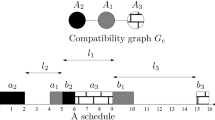Abstract
The coupled tasks scheduling problem was originally introduced for modeling complex radar devices. It is still used for controlling such devices and applied in similar applications. This paper considers a problem of coupled tasks scheduling on a single processor, under the assumptions that all processing times are equal to 1, the gap has exact integer length L and the precedence constraints are strict. We prove that the general problem, when L is part of the input and the precedence constraints graph is a general graph, is NP-hard in the strong sense. We also show that the special case when L=2 and the precedence constraints graph is an in-tree or an out-tree, can be solved in O(n) time.
Similar content being viewed by others
Explore related subjects
Discover the latest articles, news and stories from top researchers in related subjects.References
Ageev, A. A., & Baburin, A. E. (2007). Approximation algorithms for uet scheduling problems with exact delays. Operation Research Letters, 35(4), 533–540.
Ahr, D., Bekesi, J., Galambos, G., & Oswald, M.G.R. (2004). An exact algorithm for scheduling identical coupled tasks. Mathematical Methods of Operations Research, 59(2), 193–203.
Baker, K. (1974). Introduction to sequencing and scheduling. New York: Wiley.
Békési, J., Galambos, G., Oswald, M., & Reinelt, G. (2009). Improved analysis of an algorithm for the coupled task problem with uet jobs. Operation Research Letters, 37(2), 93–96.
Blazewicz, J., Ecker, K., Pesch, E., Schmidt, G., & Weglarz, J. (2007). Handbook of scheduling. From theory to applications. New York: Springer.
Brauner, N., Finke, G., Lehoux-Lebacque, V., Potts, C., & Whitehead, J. (2009). Scheduling of coupled tasks and one-machine no-wait robotic cells. Computers and Operations Research, 36(2), 301–307.
Brucker, P. (2001). Scheduling algorithms (3rd ed.). Berlin: Springer.
Brucker, P., & Knust, S. (1998). Complexity results for single-machine problems with positive finish-start time-lags. Mathematik, Reihe P, 202, 299–316.
Gupta, J. N. D. (1994). Single facility scheduling with two operations per job and time-lags (Preprint).
Hu, T. C. (1961). Parallel sequencing and assembly line problems. Operational Research, 9, 841–848.
Lehoux-Lebacque, V., Brauner, N., & Finke, G. (2009). Identical coupled tasks scheduling: polynomial complexity of the cyclic case. Les cahiers Leibnitz, 179.
Leung, J. (2004). Handbook of scheduling. London: Chapman & Hall.
Li, H., & Zhao, H. (2007). Scheduling coupled tasks on a single machine. IEEE Symposium on Computational Intelligence in Scheduling, 1–5, 137–142.
Orman, A. J., & Potts, C. N. (1997). On the complexity of coupled tasks scheduling. Discrete Applied Mathematics, 72, 141–154.
Orman, A. J., Potts, C. N., Shahani, A. K., & Moore, A. R. (1996). Scheduling for the control of a multifunctional radar system. European Journal of Operational Research, 90, 13–25.
Orman, A. J., Shahani, A. K., & Moore, A. R. (1998). Modelling for the control of a complex radar system. Computers and Operations Research, 25, 239–249.
Potts, C. N., & Whitehead, J. D. (2007). Heuristics for a coupled-operation scheduling problem. Journal of the Operational Research Society, 58(10), 1375–1388.
Shapiro, R. D. (1980). Scheduling coupled tasks. Naval Research Logistics Quarterly, 27, 477–481.
Ullman, J. D. (1976). In E. G. Coffman et al. (Eds.), Computer and job-shop scheduling theory (pp. 155–159). New York: Wiley.
Whitehead, J. (2002). Ph.D. thesis, University of Southampton.
Yu, W. (1996). The two-machine flow shop problem with delays and the one-machine total tardiness problem. Technische Universiteit Eindhoven.
Author information
Authors and Affiliations
Corresponding author
Rights and permissions
About this article
Cite this article
Blazewicz, J., Ecker, K., Kis, T. et al. Scheduling of coupled tasks with unit processing times. J Sched 13, 453–461 (2010). https://doi.org/10.1007/s10951-010-0167-z
Published:
Issue Date:
DOI: https://doi.org/10.1007/s10951-010-0167-z




